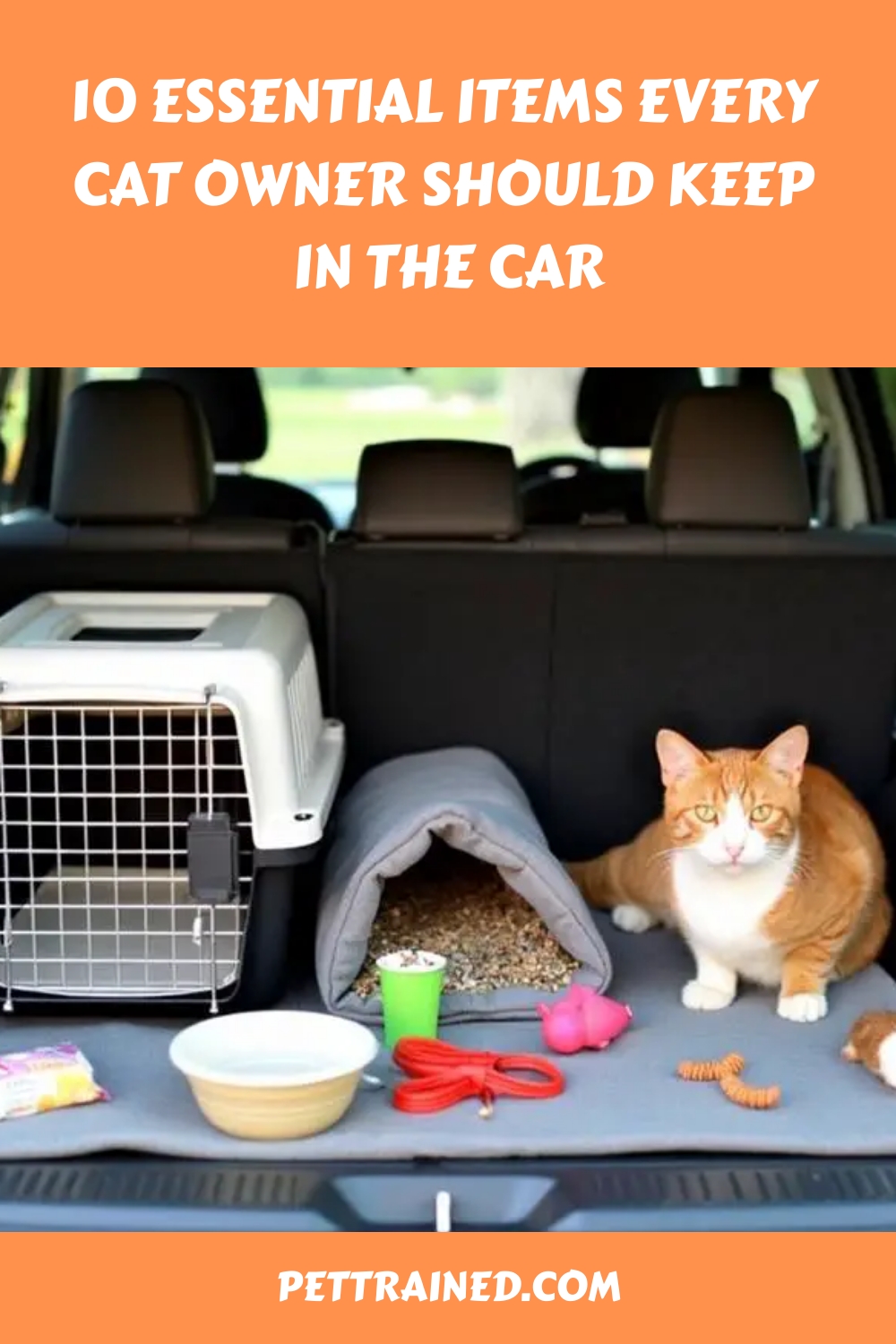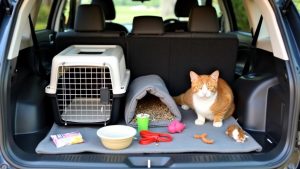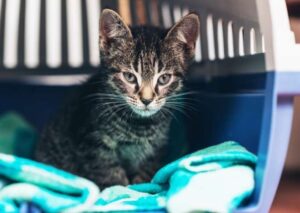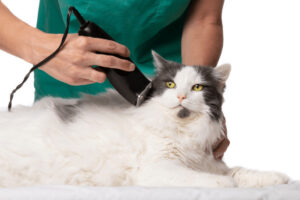Did you know that cats can experience motion sickness just like humans? It’s one of the many reasons why being prepared for car travel with your feline friend is vital. As a cat owner, you’re likely aware of the basics, but there’s more to take into account than just a carrier and some food. Whether you’re planning a cross-country move or a quick trip to the vet, having the right items on hand can make all the difference in your cat’s comfort and safety. Let’s explore the essential items you should always keep in your car to guarantee smooth travels with your furry companion.
Table of Contents
Portable Carrier
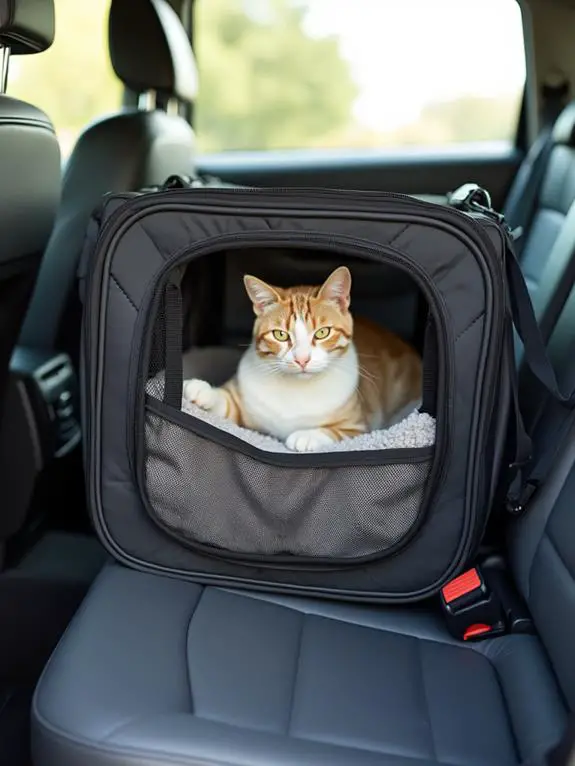
A cat’s portable carrier is an indispensable item for any feline owner. This essential apparatus guarantees safe transportation and containment of your feline companion during vehicular travel or veterinary visits.
When selecting a carrier, prioritize specific carrier features that enhance both comfort and security. Opt for a model with adequate ventilation to maintain ideal air circulation and prevent hyperthermia. The carrier should be constructed of durable, easy-to-clean materials to facilitate proper hygiene and decontamination.
Airline-approved carriers are particularly suitable for long-distance travel, meeting specific size and security requirements while providing necessary comfort for your cat.
For best travel safety, choose a carrier with secure latches and a sturdy base to prevent accidental opening or instability during transit. The dimensions should allow your cat to stand, turn, and lie down comfortably. Consider carriers with multiple entry points to facilitate easier ingress and egress. Some models feature removable tops, enabling more accessible examination during veterinary consultations.
This post contains affiliate links. However all the information provided on this site are my own honest opinions. See more in Disclaimer.
To acclimate your feline to the carrier, place it in a familiar environment with positive associations. Gradually introduce short periods of confinement, progressively increasing duration. This systematic desensitization can greatly reduce stress during actual travel scenarios.
Remember to secure the carrier with a seatbelt or other restraint system to prevent shifting during sudden stops or collisions.
Water and Collapsible Bowl
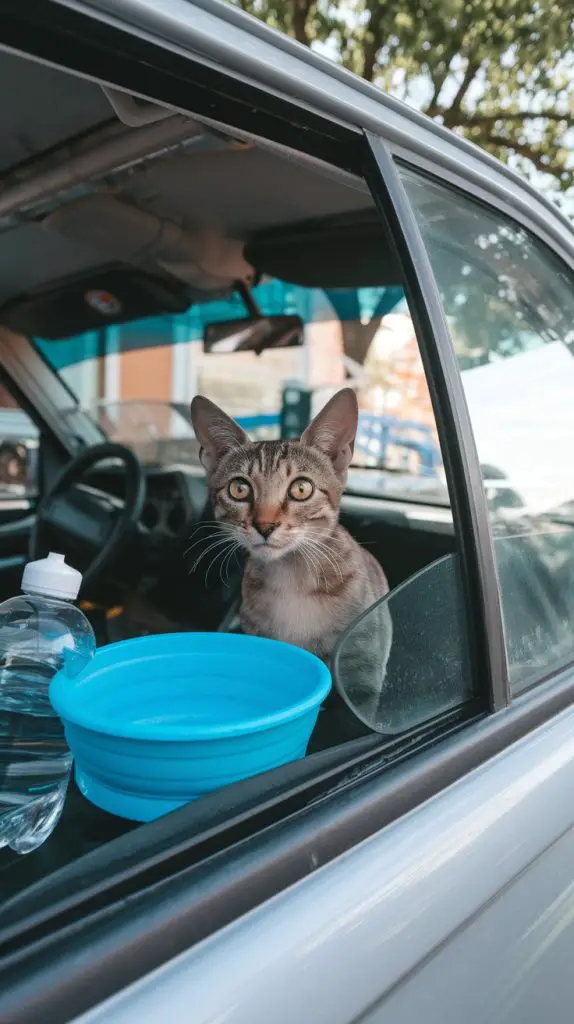
Proper hydration is vital for feline health, making a water supply and collapsible bowl indispensable components of a cat owner’s travel kit. Maintaining adequate fluid intake is essential for preventing urinary tract infections, kidney problems, and dehydration-related complications in cats.
You’ll need to carry a sufficient quantity of fresh, potable water to meet your feline’s hydration needs during transit. Consider using a portable water bottle with a built-in bowl for convenient, mess-free hydration on-the-go, similar to those designed for dogs.
A collapsible bowl offers a practical solution for providing water in confined spaces. These lightweight, portable containers are designed to fold flat when not in use, optimizing storage efficiency in your vehicle.
Select a bowl made from BPA-free, food-grade materials to guarantee your cat’s safety. When traveling, offer water at regular intervals to maintain your cat’s hydration status.
Be mindful of the hydration importance, especially during extended journeys or in warm weather conditions. Monitoring your cat’s water intake can help prevent heat stress and promote overall well-being.
Incorporating a water supply and collapsible bowl into your travel preparations enhances feline comfort and contributes to travel safety. By prioritizing your cat’s hydration needs, you’re taking proactive steps to safeguard their health during transportation.
First Aid Kit
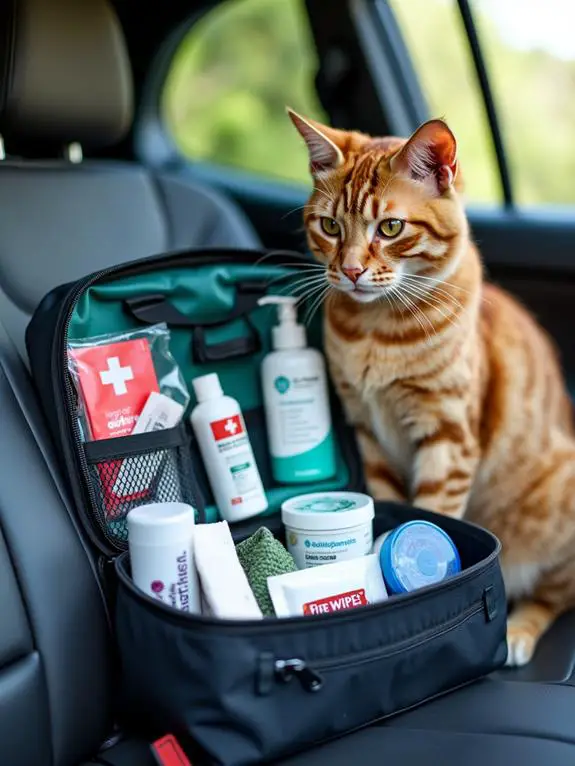
Equipping yourself with a thorough first-aid kit is essential for addressing potential feline emergencies during travel. Your cat’s health and emergency preparedness should be top priorities when assembling this kit.
Include sterile gauze pads, adhesive tape, scissors, tweezers, and disposable gloves. Incorporate a digital thermometer for monitoring your cat’s body temperature and a small flashlight for examinations in low-light conditions.
Stock your kit with antiseptic wipes, saline solution for wound cleaning, and styptic powder to control minor bleeding. Include an elastic bandage for immobilizing potential sprains or fractures. Add activated charcoal to address potential poisoning incidents, but only administer under veterinary guidance.
Include any prescribed medications your cat regularly takes, along with a copy of their medical records and vaccination history. Familiarize yourself with basic feline first-aid procedures and keep emergency contact information for veterinarians along your travel route.
Regularly check and replenish your kit’s supplies to guarantee readiness. By maintaining a well-stocked first-aid kit, you’ll be prepared to address minor injuries and stabilize your cat until professional veterinary care can be obtained.
Litter Box and Litter
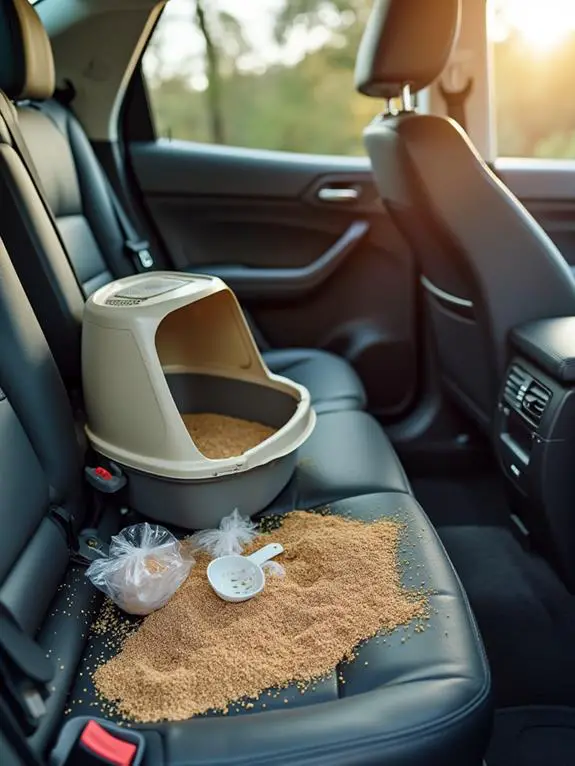
Selecting an appropriate litter box and litter is essential for maintaining your cat’s hygiene and comfort. When considering travel tips for feline companions, it’s vital to include a portable litter box and sufficient litter in your emergency preparedness kit.
Opt for a collapsible or disposable litter box that’s easily stored in your vehicle. Choose a clumping litter for ideal odor control and ease of cleaning during transit. For those seeking a more permanent solution for home use, top entry litter boxes offer excellent odor control and reduced litter tracking, which can be beneficial in small living spaces. These boxes often include features like built-in scoops for added convenience.
Ensure the litter box’s dimensions accommodate your cat’s size and allow for natural elimination behaviors. A general rule is to select a box 1.5 times the length of your cat.
For extended trips, calculate the amount of litter needed based on your cat’s daily usage, typically 2-3 inches depth. Consider hypoallergenic, dust-free options to minimize respiratory irritation in confined spaces.
Maintain proper sanitation by including disposable gloves, waste bags, and a small scoop in your travel kit. Regularly clean the litter box to prevent the accumulation of harmful bacteria and unpleasant odors.
Leash and Harness
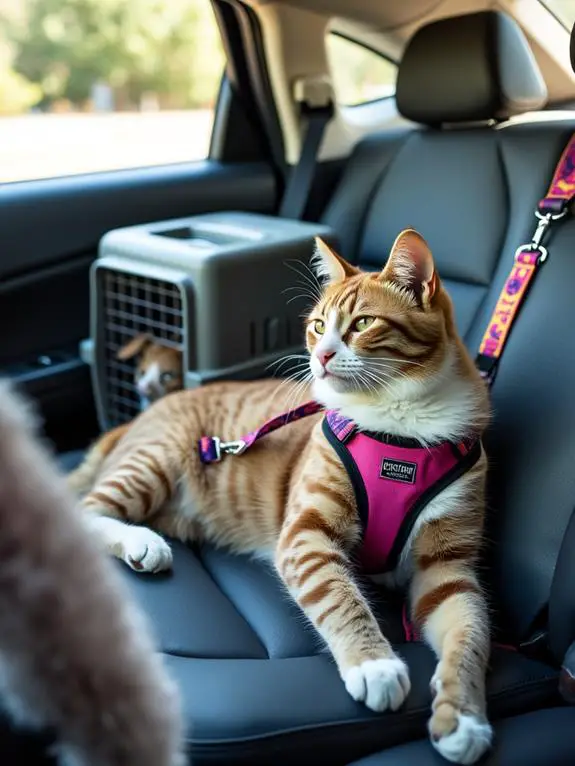
Why are leashes and harnesses vital for cat owners? These items provide important restraint and control during feline transportation, guaranteeing cat safety and travel comfort. A properly fitted harness distributes pressure evenly across the cat’s body, minimizing the risk of injury or escape.
Regular use of these tools can also help strengthen the bond between you and your cat, similar to the effects of routine grooming. When selecting a harness, consider the following criteria:
- Material: Opt for breathable, durable fabrics such as nylon or mesh.
- Size: Confirm a snug fit that allows for two fingers’ width between the harness and the cat’s body.
- Design: Choose models with adjustable straps and secure fasteners.
Leashes should be lightweight yet sturdy, with a length of 4-6 feet for best control. Retractable leashes aren’t recommended due to potential safety hazards.
Prior to travel, acclimate your cat to the harness and leash through gradual exposure and positive reinforcement. During rest stops, secure your cat using the leash and harness to prevent escape.
Regular inspection of these items is vital to maintain their integrity and effectiveness. By incorporating leashes and harnesses into your cat travel protocol, you greatly enhance feline safety and reduce the risk of adverse events during transportation.
Blanket or Towel
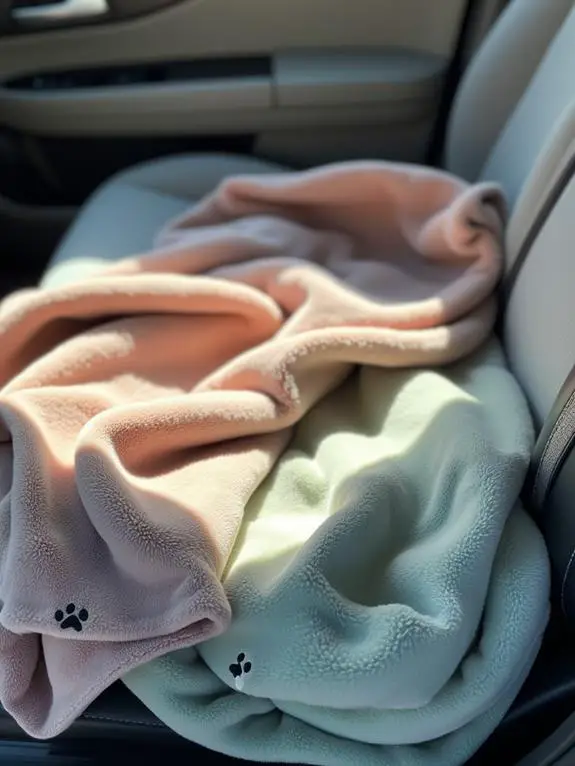
While leashes and harnesses provide physical control, a blanket or towel offers comfort and security for your feline companion during travel. These versatile items serve multiple purposes in guaranteeing cat comfort and travel safety.
Keep a clean, soft blanket or towel in your vehicle for the following reasons:
- Thermal regulation: Helps maintain your cat’s body temperature in varying climatic conditions
- Stress reduction: Provides a familiar scent and texture, reducing anxiety during transportation
- Containment: Acts as a makeshift carrier in emergency situations
- Hygiene maintenance: Useful for cleaning spills or accidents during the journey
When selecting a blanket or towel for your cat, opt for materials that are hypoallergenic and easily washable. Microfiber or cotton fabrics are ideal choices due to their absorbency and softness.
For added protection against spills and messes, consider using a waterproof PU leather mat underneath the blanket, which can be easily wiped clean and maintain a tidy environment in your car. Verify the item is free from loose threads or frayed edges that could pose a risk of entanglement or ingestion.
Regularly launder the blanket or towel to maintain hygiene and eliminate accumulated allergens or pathogens. Keep multiple clean options in your vehicle to address unexpected situations.
Treats and Dry Food
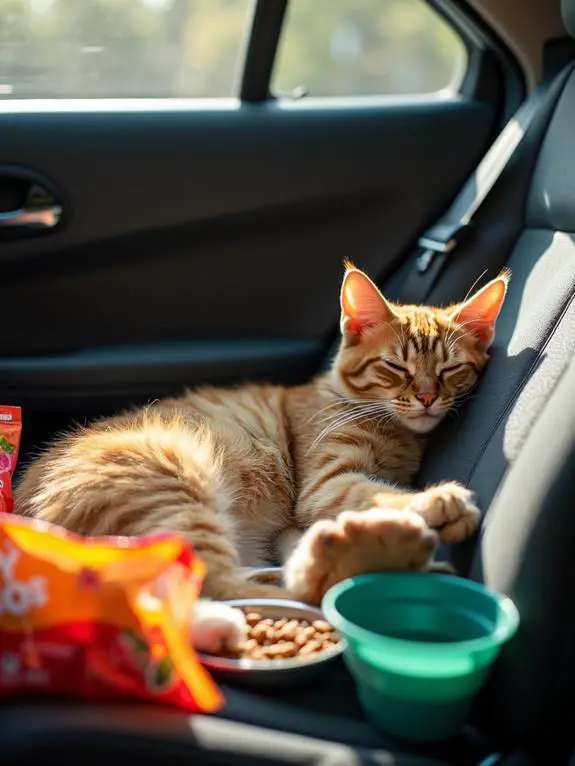
Treats and dry food are fundamental components of a cat’s travel kit, serving both nutritional and behavioral purposes. When transporting your feline companion, it’s important to maintain their dietary routine and provide sustenance during extended journeys.
Select high-quality, nutrient-dense dry food that meets your cat’s specific nutritional requirements, considering factors such as age, weight, and health status. Portable, sealable containers are ideal for storing dry food, ensuring freshness and preventing contamination.
Portion control is essential; measure out appropriate amounts to avoid overfeeding during travel. Treats serve a dual purpose: they can be used as a reward for good behavior and to alleviate stress in unfamiliar environments. Opt for low-calorie, easily digestible treats to prevent gastrointestinal upset.
When choosing treats and dry food for travel, prioritize products with extended shelf lives and resealable packaging. Consider your cat’s preferences and any dietary restrictions.
Always have fresh water available alongside food to maintain proper hydration. By incorporating treats and dry food into your travel preparations, you’re ensuring your cat’s nutritional needs are met while promoting travel safety and comfort.
Cleaning Supplies
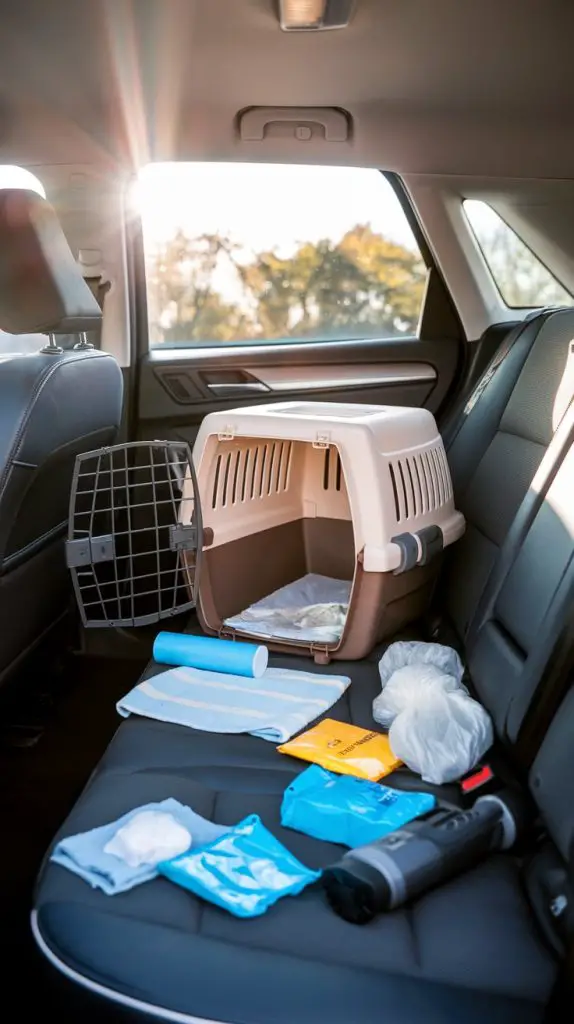
Maintaining proper hygiene for your feline companion is vital, and having the right cleaning supplies on hand is indispensable. Effective cat mess management and car odor elimination are essential aspects of responsible pet ownership.
When traveling with your feline, make sure you’re equipped with the following essential cleaning supplies:
- Enzymatic cleaner: This specialized solution breaks down organic matter, effectively neutralizing odors and removing stains caused by urine, feces, or vomit.
- Disposable gloves: Protect yourself from potential zoonotic pathogens when handling cat waste or cleaning contaminated surfaces.
- Absorbent paper towels: Quickly contain and remove liquid spills, minimizing the spread of contaminants within the vehicle.
- Sanitizing wipes: Disinfect surfaces after initial cleaning to eliminate residual bacteria and viruses.
In addition to these items, consider carrying a compact handheld vacuum for efficient removal of cat hair and litter particles. A spray bottle filled with a diluted vinegar solution can serve as an eco-friendly deodorizer for fabric surfaces.
Remember to regularly clean and disinfect your cat’s carrier to maintain ideal hygiene during travel.
Air purifiers can also be beneficial for maintaining indoor air quality and reducing litter box odors, especially during extended car trips.
Vaccination Records
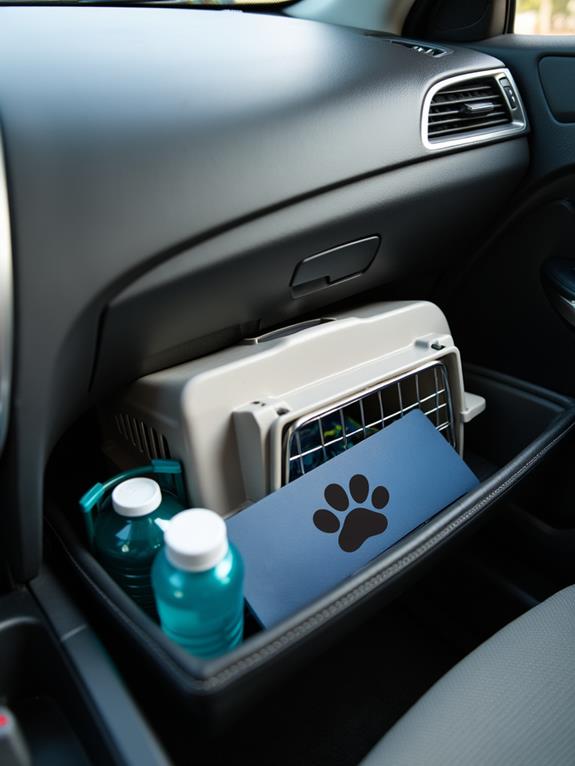
Three vital vaccination records should accompany your cat during travel: rabies, FVRCP (feline viral rhinotracheitis, calicivirus, and panleukopenia), and FeLV (feline leukemia virus). These documents serve as proof of your cat’s immunization status, essential for interstate travel, boarding facilities, and emergency veterinary care.
The importance of vaccination can’t be overstated in maintaining your cat’s health and preventing the spread of communicable diseases. Rabies vaccination is legally mandated in most jurisdictions, while FVRCP protects against common feline respiratory and gastrointestinal pathogens. FeLV vaccination is recommended for cats with outdoor exposure or those living in multi-cat households.
Organizing records effectively guarantees quick access during travel. Create a dedicated folder for your cat’s medical documents, including vaccination certificates, dates of administration, and due dates for boosters.
Consider digitizing these records and storing them securely on your mobile device for easy retrieval. Regularly update this information after each veterinary visit to maintain accuracy.
Favorite Toy
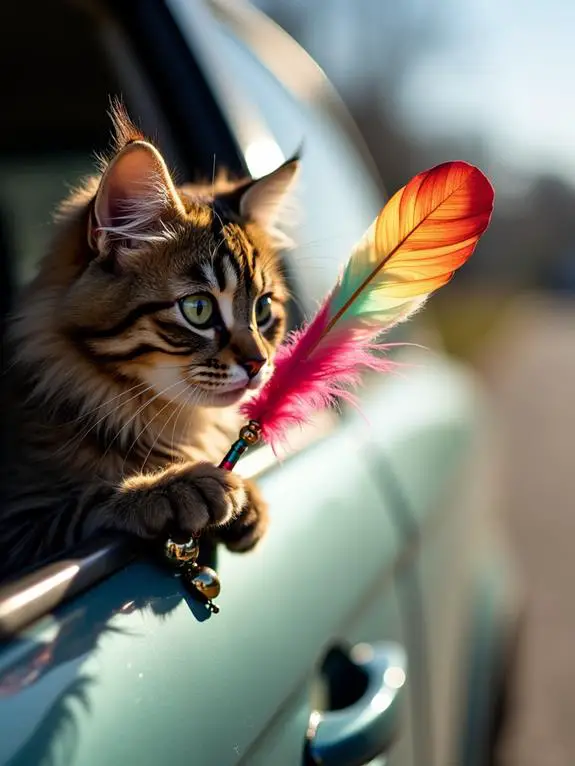
While vaccination records safeguard your cat’s health, a favorite toy serves as an essential component of their emotional well-being during travel. Feline stress reduction through familiar objects is a well-documented phenomenon in veterinary behavioral science.
When selecting a toy for vehicular transport, consider the following criteria:
- Non-toxic materials
- Absence of small, detachable parts
- Durability to withstand prolonged manipulation
- Appropriate size for confined spaces
Prioritize cat comfort by choosing a toy that your feline has consistently engaged with in the home environment. This familiarity can mitigate travel-induced anxiety and promote a sense of security.
For nighttime travel, consider LED-equipped toys that can provide gentle illumination and engagement. Toy safety is paramount; avoid items with strings, ribbons, or other potential entanglement hazards. Regularly inspect the toy for signs of wear or damage to prevent accidental ingestion of fragments.
Incorporate the toy into pre-travel routines to establish positive associations. During transit, periodically offer the toy to your cat, but avoid forced interaction. The mere presence of the familiar object can provide comfort.
In cases of extreme travel anxiety, consult your veterinarian about complementing toy therapy with appropriate feline anxiolytics to guarantee peak cat comfort and safety during transportation.
Frequent Questions and Answers
Time flies when it comes to your cat’s travel kit essentials. You should regularly inspect and replace worn items. Assess perishables monthly, and non-perishables quarterly. Maintain clinical precision by adhering to expiration dates for medications and consumables.
You should adhere to cat travel laws and prioritize pet vehicle safety. Utilize a secure carrier, properly restrained during transit. Many jurisdictions mandate containment of felines in moving vehicles to prevent driver distraction and guarantee maximum feline safety.
Did you know 64% of cats experience travel anxiety? To alleviate your feline’s distress, implement cat calming techniques like pheromone sprays or prescribed anxiolytics. Travel anxiety remedies include desensitization training and maintaining a consistent, soothing environment during transport.
You should maintain your cat’s regular feeding schedule to minimize travel stress. Offer a small meal 3-4 hours before departure. During long journeys, provide water but avoid food to prevent motion sickness and gastrointestinal distress.
